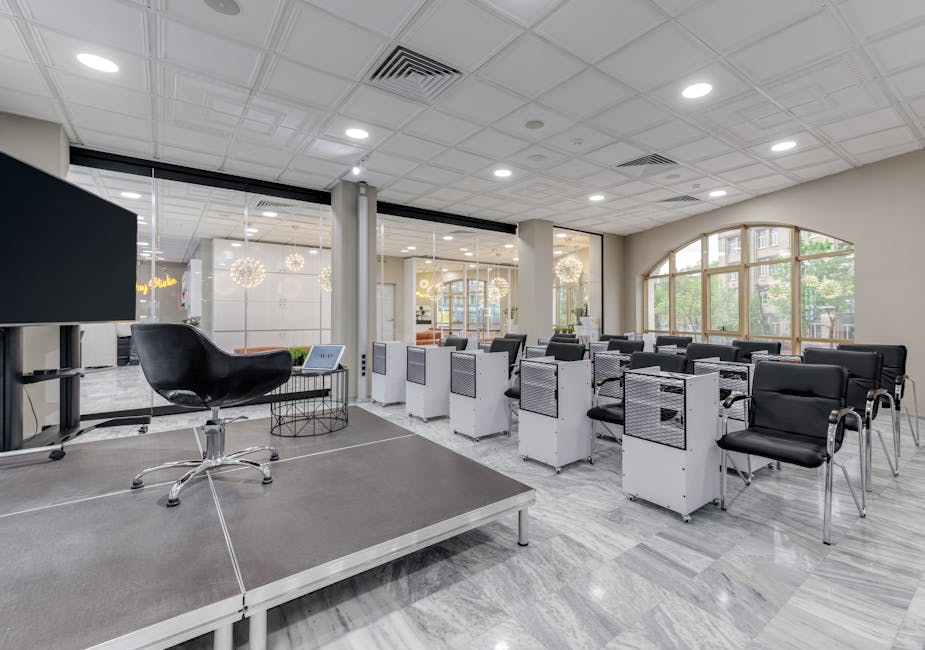Revolutionizing Collaboration: The Rise of Hybrid Meeting Rooms
“As workplaces evolve, hybrid meeting rooms are becoming essential for seamless collaboration. This article delves into the technology, best practices, and cultural shifts necessary to create effective hybrid spaces that cater to both remote and in-office employees. ”

Revolutionizing Collaboration: The Rise of Hybrid Meeting Rooms
In the wake of global changes that have reshaped our work environments, the concept of hybrid meeting rooms has emerged as a crucial component of the modern workplace. These innovative spaces are designed to bridge the gap between remote and in-office employees, fostering collaboration and productivity in an era where flexibility is key.

The Evolution of Meeting Spaces
Traditional meeting rooms, once the cornerstone of office collaboration, have undergone a significant transformation. The shift towards hybrid work models has necessitated a reimagining of these spaces to accommodate both physical and virtual participants seamlessly.
From Conventional to Cutting-Edge
Gone are the days of simple conference tables and whiteboards. Today's hybrid meeting rooms are equipped with state-of-the-art technology that enables real-time interaction between on-site and remote team members. High-definition cameras, advanced audio systems, and interactive displays are now standard features, ensuring that everyone can participate fully, regardless of their location.
Key Components of Effective Hybrid Meeting Rooms
To create a truly functional hybrid meeting space, several essential elements must be considered:
- Advanced Audio-Visual Technology: Crystal-clear video and audio are non-negotiable for effective remote participation.
- Interactive Collaboration Tools: Digital whiteboards and screen-sharing capabilities facilitate real-time idea exchange.
- Flexible Furniture: Modular seating and adaptable layouts accommodate various meeting styles and group sizes.
- Robust Connectivity: High-speed internet and reliable Wi-Fi are crucial for uninterrupted communication.
- User-Friendly Interfaces: Intuitive controls for room technology ensure smooth meeting transitions and reduce technical difficulties.

Best Practices for Hybrid Meetings
Implementing hybrid meeting rooms is just the first step. To maximize their potential, organizations should adopt the following best practices:
1. Prioritize Inclusivity
Ensure that remote participants have equal opportunities to contribute by actively soliciting their input and using collaborative tools that level the playing field.
2. Establish Clear Communication Protocols
Set guidelines for meeting etiquette, such as using the "raise hand" feature for questions and muting microphones when not speaking, to maintain order and efficiency.
3. Provide Technical Training
Offer comprehensive training to all employees on how to use the hybrid meeting room technology effectively, reducing the likelihood of technical disruptions.
4. Schedule Thoughtfully
Consider time zones and work schedules when planning meetings to accommodate both in-office and remote team members.
5. Encourage Camera Use
Promote a "cameras on" culture to foster better engagement and non-verbal communication among all participants.
The Impact on Workplace Culture
The adoption of hybrid meeting rooms goes beyond technological upgrades; it represents a fundamental shift in workplace culture. These spaces embody the principles of flexibility, inclusivity, and employee empowerment that are central to the modern work environment.
Fostering Collaboration and Innovation
By breaking down geographical barriers, hybrid meeting rooms enable diverse teams to collaborate more effectively, leading to increased innovation and problem-solving capabilities.
Enhancing Employee Satisfaction
Offering the flexibility to participate in meetings from any location can significantly improve employee experience and work-life balance, contributing to higher job satisfaction and retention rates.

Overcoming Challenges in Hybrid Collaboration
While hybrid meeting rooms offer numerous benefits, they also present unique challenges that organizations must address:
1. Technology Equity
Ensure that remote participants have access to equivalent technology at home to maintain a level playing field.
2. Meeting Fatigue
Combat video conferencing fatigue by incorporating breaks and varying meeting formats to keep participants engaged.
3. Cultural Integration
Develop strategies to maintain a cohesive company culture that includes both in-office and remote employees.
4. Security Concerns
Implement robust cybersecurity measures to protect sensitive information shared during hybrid meetings.
The Future of Hybrid Meeting Rooms
As technology continues to evolve, we can expect hybrid meeting rooms to become even more immersive and intuitive. Advancements in virtual and augmented reality may soon allow remote participants to feel as if they're physically present in the room, further blurring the lines between in-person and virtual collaboration.
Conclusion: Embracing the Hybrid Work Revolution
Hybrid meeting rooms are not just a temporary solution but a long-term investment in the future of work. By embracing these innovative spaces, organizations can create a more flexible, inclusive, and productive work environment that meets the needs of today's diverse workforce.
As we continue to navigate the complexities of hybrid work, one thing is clear: the ability to seamlessly blend remote and in-office experiences will be a key differentiator for successful businesses in the years to come. By prioritizing the development of effective hybrid meeting rooms, companies can position themselves at the forefront of this workplace revolution, ready to adapt and thrive in an ever-changing business landscape.